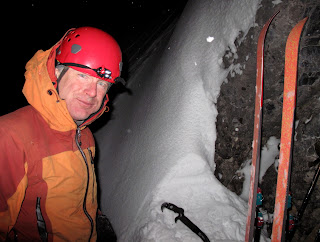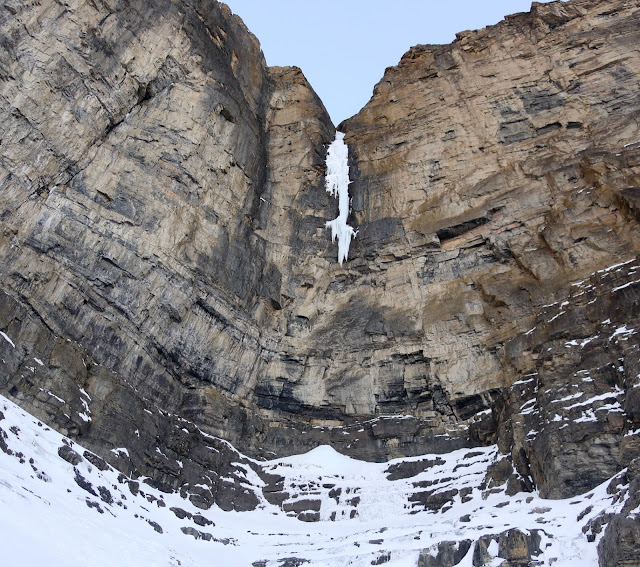The Peach
March 2008. In between overnight alpine outings, Pierre Darbellay and I took a break from big mountains and big packs to head up Storm Creek. We had already enjoyed a couple of good days up there, climbing some fantastic, weirdly-iced new ground. We wanted to see if there was any more hidden further up the valley. As we skied along, an imposing hanging dagger with an overhanging scoop of yellow rock came into view. We found our objective. In fact, we found more than we had bargained for, and we retreated from below a radically overhanging crack with our tails between our legs.
March 2011. After a three-year absence from Storm Creek ice, I head back there with Grant Meekins. With all the recent snow the track has disappeared, but the snowpack is supportive and we make good time up the valley. Two and a half hours after leaving the car we drop our packs at the mouth of a small rock cave and crane our heads back to gawk at the climb. Pretty but kind of short, says Grant. I remind him of Barry's dictum, that if it was not for foreshortening nobody would get up anything. We eat, drink, gear up, and swim up deep snow into the cleft holding the first pitch.
The Peach in its full glory from across the valley.
The ice pillar looks nice but straightforward enough. I whack in a tool and am rewarded with a cut on the bridge of my nose, as a large chunk explodes in my face. Unexpectedly I am actually having to think about where to put my tools and crampons, and place the occasional screw. Above the pillar I slog up a small snowfield and anchor to ice that has dripped from the broken dagger far above. I lean back and look at the bail sling I left three years ago, halfway up the overhanging crack. I am both dreading and looking forward to doing battle with it.
Funny how ice is always harder than it looks. Topping out on the first pitch. Photo: Grant Meekins.
Grant takes the second pitch up a less-than-vertical rock face. It looks like glorified scrambling, but having done it before I am not fooled. The angle might be kicked back, but as Grant works his way up, a steady stream of discarded hand-and footholds pits the snow below. As I follow it, cleaning the gear is easy enough, some of the pins simply coming out in my hand. The pitch is a nice example of why alpine climbing often seems hard in spite of often underwhelming grades. Sure, the climbing might be only 5.9 or M6 or whatever - provided everything one pulls on actually stays put.
Looks like piss but climbs like the real thing. I suppose it does not help that most of the holds are portable, and half of the pins can be cleaned by hand. Grant starting up the second pitch, with the third and fourth pitches, and the final dagger, looming above.
I tighten my boots, grab all the rock gear we brought but leave the screws behind, and step up to the crack. A good pin gives me the confidence to paste my cramponed feet on the polished rock and start climbing. A big reach to chockstone with an old sling around it, a big cam goes into gritty rock next to it just in case, and I punch it. Like liebacking a granite crack, continuous motion is the key here. An arm bar lets me get my breathing back under control. I fiddle in more gear, and stem for all I am worth to snag a loose ledge.
The next order of business is finding a decent anchor - a tall order in a world of shattered limestone. I feel the gentle but insistent pull of the bolt kit on the back of my harness. No, dammit! I am not going to profane this route by placing a bolt I do not absolutely need! I am glad I brought a proper rock hammer, as I blast through layers of choss to drive knifeblades into better rock underneath. I add a rock thread and at last I have something resembling a solid anchor. Yipee!
Doing battle with the crux third pitch: good gear, good tool placements, lousy feet. Photo: Grant Meekins.
Unfortunately the ice on the third pitch did not help with the climbing, being just out of reach, but it was good decoration. Photo: Grant Meekins.
Grant graciously lets me have the last pitch. It looks really cool, hard but not outrageously so. But with every move up the overhanging corner I am acutely aware of the painful smack into the ledge below I would incur if I should fall. I try to get into position to place a pin but to no avail. In the end I hang from a tool hooked in a patch of ice and whale in two good pins. Ever the sport climber, I step back down to a no-hands stance to ensure a legitimate redpoint. My focus drifts and the first attempt results in testing the pins with a short fall. They hold, and after lowering again to the ledge, I climb past them and gun for the ice. Swinging is awkward in the tight confines between rock and, ice, but in the end I manage a good stick. Relief! Still, the ice is anything but cruisy, and daylight is noticeably fading by the time I anchor to the last of the ice before it turns into a snow slope.
Getting down to business on the fourth pitch. You gotta love loose rock: so many cracks to choose from. Photo: Grant Meekins.
Breathing a sigh of relief upon getting established on the ice. Photo: Grant Meekins.
With the days being long and the route short, I did not think it necessary to bring a headlamp. Yet here I am at the top of the route, with darkness falling even more rapidly in the falling snow. Fortunately Grant makes quick work of the ice, and before long we are sliding down the ropes, past the lip of the broken dagger and over a spectacular overhang. The ropes pull easily, the knot is already down - and then they stop. No amount of yarding can undo whatever happened to the far end of rope. In the end there is nothing for it but to abandon one of our cords, and to make two more raps instead of one. But even a lost rope cannot wipe the grins from our faces. It has been a grand adventure.
All that is left is to ski out by headlamp with heavy packs and light boots. At least the snow is dreamy.
Summary: The first ascent of The Peach (110 m, WI5 M8), Storm Creek, by Grant Meekins and Raphael Slawinski, March 12, 2011. The climb is situated between Crash and Sinister Street. It cannot be seen until one is almost right across from it.
P1 (30 m, WI5): Climb an ice pillar in a deep cleft, and slog up snow to the base of a loose wall.
P2 (20 m, M4 or 6 or something) : Climb the wall to a loose cave (2-piton anchor up and left).
P3 (20 m, M8): Follow a wide overhanging crack up and right (3 fixed pitons) to another loose ledge (2-piton and thread anchor up and right).
P4: (40 m, WI5 M7): From the left end of the ledge climb an overhanging corner (fixed nut and 2 fixed pitons) to a broken dagger. Get on the dagger from the left and climb interesting ice to where it ends in a snow slope.
Descent: 2 60-m rappels from abalakovs.
Gear: screws, cams to #4 Camalot, and a few pitons and nuts.











Comments
Post a Comment